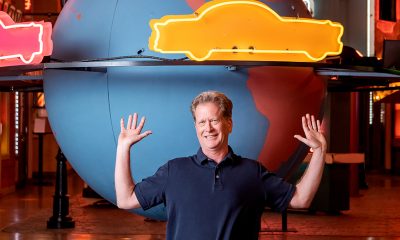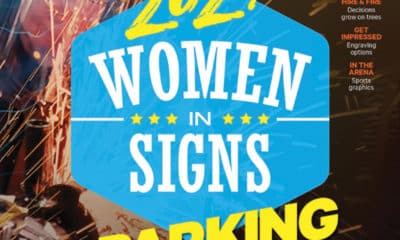Metal Fabrication
Full of Energy
Bluemedia goes
Published
17 years agoon

Every vehicle wrap that bluemedia produces is rewarding to our team. We love the opportunity to unleash our creative energy and technical expertise to help clients grow brand awareness – not to mention our reputation and bottom line.
However, Jonathan Read, president of ECOtality (Scottsdale, AZ), contacted us with a very unusual project with far-reaching goals that exceeded those of our typical client. The company, which develops, designs and licenses renewable-energy technologies, works to commercialize hydrogen as an alternative, renewable energy source.
To spur future adoption and social change, Read believes a grassroots approach of public education about hydrogen’s potential as fuel is important. Also, he believes it’s vital to manage the public’s perception of hydrogen-powered vehicles as safe and reliable, and underscore that renewable energies collectively offer real, viable alternatives to gasoline.
Ecotality believed showcasing a commercial vehicle powered by compressed-hydrogen technology – with zero emissions – and equipped with a mobile learning center would be a powerful tool to deliver this message. The ECObus contains an AV system and interactive workstations to educate Arizona’s schoolchildren and policymakers about hydrogen’s potential to replace carbon-fuel-burning vehicles. Beginning February 27, Arizonans will enjoy the opportunity to experience the ECObus as it canvasses the state.
Wisely, Read decided the vehicle’s previous teal coloration with block, cut-vinyl letters wouldn’t create a first-impression buzz, so he contacted us to develop a wrap for the 40-ft.-long, 13-ft.-tall, multimillion-dollar behemoth.
Advertisement360° design
Will Mejia, bluemedia’s art director, met with Read to determine his promotional objectives. Ecotality desired graphics that conveyed a natural or global theme that underscored the context of “green” technology. Considering Ecotality’s relationship with NASA, Mejia chose to browse satellite photos from NASA’s collection to find appropriate cosmos imagery. We stylized and color-corrected the photo to emphasize the Hydratus logo and the midnight-black and blue and green hues prominent on Earth photos from space.
To establish our framework, Mejia created a 10%-scale, vector template that captured the bus’ unique contours and curves. We used Adobe Photoshop® and Illustrator® to develop our graphic solution.
Fabrication thoughts
The bus surface comprised custom fiberglass, so it required a thorough alcohol wipe in addition to the requisite, soap-and-water cleaning. We used Onyx’s Production House™ 6.5 RIP to translate the design into the printer’s program.
AdvertisementFinding the right RIP for your shop is an equation of color-profile variety, speed, flexibility and functionality.
We output the system on one of our three Mimaki JV3 solvent printers on 3M™’s Controltac™ IJ-1080C film with Comply® embossed-adhesive technology. We also operate HP, Roland DGA Corporation, |2433|, Océ USA, Epson, and Ricoh printers in our facility. The size and specific application’s conditions are the dominating factors that decide what machine we use – capacity and warranty are other factors.
We maximized the 54-in.-wide material by outputting tiled prints as closely as possible to 52 in. wide. We projected the vehicle would require 11 tiles for each side and an additional 11 on the roof (9 ft. tall for the sides, 8 ft. long for the roof); two, 9-ft.-tall panels for the rear; three, 9-ft.-tall prints for the front; and two, 34-in.-long pieces for the window strips. A ¼-in. overlap allows the 40 panels to integrate seamlessly.
The new-generation adhesives are an installation godsend because they allow easy repositioning. To topcoat the wrap, we applied 3M Industrial Adhesives & Tapes Div.’s 8519 glossy laminate. There’s usually some debate over whether to use a glossy-, luster- or matte-finish laminate. Because this bus will be touring for several months and making conspicuous entries into schools, we used a laminate that provides a high sheen.
The installation, especially fitting the film over the bus’ curves and upper edges, proved to be some¬what challenging. To smooth the film into place, we used torches to conform the media. People often perceive that Arizona’s climate maintains a perpetual heat wave, but the ambient temperature during our January installation ranged from 45 to 65° F. In this lower temperature range, a heat source becomes a vital tool.
Advertisement
However, elbow grease and skilled hands served as the greatest assets when installing the horizontal panels on the bus roof. Whereas many vehicle installs only require a two-man team, this bus required a minimum of four workers to apply these panels. With vertical panels, gravity helps by starting to squeegee at the top and working your way down. With horizontal panels, it’s important to work slowly and keep the panels registered. And, of course, it requires a multi-tiered scaffolding setup.
The Ecotality bus also features a considerable amount of surface venting. To conform the film over the vents, we first laid the film over the vents as if it’s a perfectly flat surface. Then, after the panel was in place, an installer used an Olfa knife to deftly remove excess film.
Final thoughts
The wrap required two full days to install and a few more hands than usual. But, it was a very unique and rewarding project. And, we took a little more ownership of the client’s concept than we typically would. Because it’s such an innovative and socially relevant subject, we took it upon ourselves to help market the concept by coordinating press releases and regional promotional opportunities through our PR firm. We’re optimistic that the wrap will successfully help build awareness of hydrogen-cell technology.
More about bluemedia
Jared Smith founded bluemedia (Tempe, AZ) in 1998 to serve the large- and grand-format market with banners, vehicle graphics, banners and various POP applications. The company has garnered several high-profile clients, which include Coca-Cola®, Clear Channel Communications and Wells Fargo, among others. In the process, the company has won numerous awards, including first-place victories in the Banner/Soft Signage and Vehicle Graphic categories of the 2006 ST/ISA International Sign Contest.
Bluemedia owners recently broadened their repertoire and launched a sister company, www.blindsociety.com, which will undertake nontraditional advertising campaigns to help brands reach younger consumers.
More about ECOtality
ECOtality Inc. (Scottsdale, AZ) leverages global research-and-development resources to develop technologies that address current and emerging, global-energy challenges. Through strategic partnerships and an aggressive development model, the company creates proprietary, “green” technologies. Currently, the company is developing Hydratus™, a hydrogen on-demand system that operates in conjunction with existing fuel-cell technology, in partnership with the NASA Jet Propulsion Laboratory.
For more information, visit www.ecotality.com.
Darren Wilson, who serves as VP of marketing for Tempe, AZ-based bluemedia, has worked with the company for seven years.
SPONSORED VIDEO
Introducing the Sign Industry Podcast
The Sign Industry Podcast is a platform for every sign person out there — from the old-timers who bent neon and hand-lettered boats to those venturing into new technologies — we want to get their stories out for everyone to hear. Come join us and listen to stories, learn tricks or techniques, and get insights of what’s to come. We are the world’s second oldest profession. The folks who started the world’s oldest profession needed a sign.
You may like
Advertisement
Subscribe

Magazine
Get the most important news
and business ideas from Signsofthetimes Magazine.
Advertisement
Most Popular
-

 News5 days ago
News5 days agoWoman Found Living Inside Supermarket Sign
-

 Projects2 weeks ago
Projects2 weeks ago4 of the Most Fun Sign Projects in Years
-

 News2 weeks ago
News2 weeks ago2024 Sign Contest Open for Submission
-

 Real Deal5 days ago
Real Deal5 days agoA Family Sign Company Foists Their Youngest Upon the Business
-

 How To1 week ago
How To1 week agoMaking the Grade with ADA Signs
-

 Editor's Note6 days ago
Editor's Note6 days agoThe Joy of Working
-

 Photo Gallery3 days ago
Photo Gallery3 days ago17 Sneak Peeks at the American Sign Museum Main Street Expansion
-

 News1 week ago
News1 week agoSign Company Owner Meets Travis Kelce

















